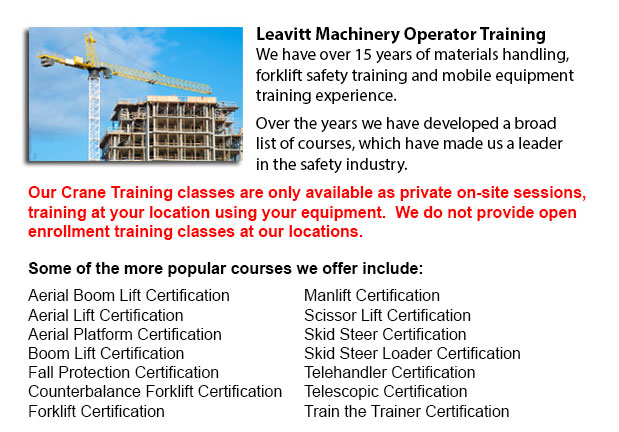
Crane Certification Red Deer - The Crane Certification training program consists of subject matter recommended by industry concerning the efficient and safe operation of cranes. Individuals training would be taught the following: how to identify cranes and their component parts; pre-operational, operational and post-operating requirements; rigging components and inspection/rejection criteria; how to determine overall lift capacity; and needs particular to the work place where the trainees would be operating.
Pre-operational requirements include assigning authority for the pre-operational check; performing the sequential pre-operational check based on the specifications certified by a professional engineer or manufacturer's specifications; checking the log book for comments; inspecting the work place for hazards and obstacles; inspecting cables, hooks, chains crane movement and safety latches; ensuring the proper functioning of operational controls; and knowing how to ensure the disconnect switch/isolator of the crane is working properly.
Operational requirements include identifying responsibilities and roles, and determining the need for a formal lift plan. Trainees would learn how to perform a danger assessment connected to environmental circumstances, physical situations and staff. Subject matter consists of determining when to seek competent support, the destination of loads and the safest route, and load weight and centre of gravity.
People training must be able to identify an over-capacity lift, in addition to be able to choose right rigging machine, select load limits, and to determine the safe spot for the crane to operate from. Trainees would review both universal and site-specific crane signals for lifts, and techniques for traveling, lifting and loading. Right maintenance habits would also be covered.
The person training will undergo an examination to test their knowledge of emergency response techniques for various conditions, particularly electrical or mechanical failures. They will be asked to describe shut down and parking procedures for security and safety, to follow lock out and tagging procedures, and to explain the reason why near misses are reported and recorded to the appropriate individual. Log book records have to be maintained.
People training would develop knowledge of rigging, particularly, establishing who has authority and responsibility for rigging, identifying different types of rigging, knowing load capacity ratings and storage procedures.
The requirements following operation of the crane would be taught also, learning to enter the deficiencies and defects; and to log the history of maintenance and service records, based on the provincial, federal and state codes requirements.
Also, we include site-specific requirements to be able to meet the employers requirements into our crane certification training program.
-
Fall Protection Ticket Red Deer
Fall Protection Ticket Red Deer - The number one reason of death in the construction industry come from fall-related incidents. There is more possibility for fall accidents depending upon the kinds of work being done in your workplace. Therefore, kno... More -
Overhead Crane Certification Red Deer
Overhead Crane Certification Red Deer - The overhead crane certification course is a course that is designed to help trainees, even if they have language or literacy limitations. The course comprises a practical hands-on training session and a classr... More -
Wheel and Track Loader Training in Red Deer
Lift trucks are obtainable in a variety of various models which have various load capacities. Nearly all typical lift trucks utilized in warehouse settings have load capacities of 1-5 tons. Bigger scale models are utilized for heavier loads, like for... More -
Heavy Equipment Certification Red Deer
Heavy Equipment Certification Red Deer - Heavy duty vehicles are big pieces of machines which are usually known as heavy equipment. It is a broad term that literally includes whatever big utility vehicle in the area of agricultural and forestry imple... More -
Heavy Equipment Operator Classes Red Deer
Heavy Equipment Operator Classes Red Deer - A person who has the correct training to be able to use a particular kind or piece of machine is referred to as an equipment operator. There are different ways that an equipment operator can become trained... More -
Forklift Training Programs Red Deer
Forklift Training Programs Red Deer - Are you searching for a job as a driver of a forklift? Our regulatory-compliant mobile equipment operator training offers instruction in kinds of lift trucks, pre-shift check, fuel types and dealing with fuels, a... More -
Crane Safety Training Red Deer
Crane Safety Training Red Deer - Both crane driver and their supervisors must know all the potential problems related to the operation of an overhead crane. All over North America, there is legislation which provides rules for the safe inspection, ma... More -
Aerial Lift Training Red Deer
Aerial Lift Training Red Deer - An aerial work platform is a mechanized access platform. This device provides access to otherwise inaccessible places for people or equipment. Likewise called an elevating work platform or aerial device, the machinery... More

Forklift Training Red Deer
TOLL FREE: 1-888-254-6157
Red Deer, Alberta
forklifttrainingreddeer.com
Email Us
About Us


